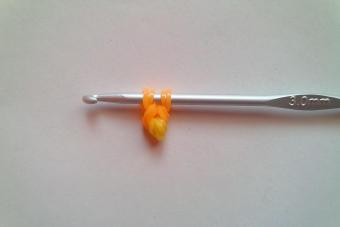- fabulous creatures that appeal to both adults and children.
If everyone likes them so much, why not make yourself one (or a couple)?
Such handmade dragon can serve as an excellent one, especially for a person who is passionate about this topic.
Today's one is provided for our site by a forum member Irbisina from the HobbyPortal forum, where you can read the original of her master class on dragons made of paper, wire, rope and mass for modeling.
So if you decide make your own dragon, first draw it sketch or choose an image you like, since there are more than enough pictures of dragons on the Internet.
Now it's time to think about what size your dragon how the wire will be located in his body frame. Cut the wire for the frame: body, paws, wings.
To do it yourself connect separate pieces of wire
you can solder them or tightly wrap them with tape, electrical tape, thin sections even with threads.
For carcass adhesions you need to remove the varnish from the wire with the help of a skin with your own hands, irrigate the soldering points (the tinned surface is better wetted with solder) and solder the frame.
Give the frame an approximate form and solder it:
let's get busy paws: solder, cut to the desired length, sharpen the claws with a needle file and bend them.
Here is what ours looks like at this stage the Dragon self made
. Still far from perfect:
Now it is very important to make sure that the legs of the dragon turned out the same length.
(removing the paper wound after) and shorten the leg by 1.5 cm.
Now arming toilet paper and wrap it with your own hands frame in one layer.
We cover with divorced glue PVA and let dry.
When the glue has dried, tear off the paper in small pieces, compress with our own hands and we wind it to the dragon (threads),
then we wrap toilet paper over it until it forms the thickness we need all parts of the dragon:
On the legs we act similarly, only more carefully than on a thick torso,
handmade dragon is already taking shape:
When you wrap the whole dragon with paper, coat it well with glue and let it dry.
Usually dragons are covered scales. In order to create its likeness, the author uses a rope with the amazing name "Recycled Packaging". It must be glued onto the dragon's body using a universal transparent glue (for example, Moment).
Instead of a rope, you can use flagella twisted from toilet paper.
We begin to glue where the rope can go in a circle (in the photo - the neck of the dragon), it is easier to pre-lubricate the surface with glue with your own hands.
We wrap neck and go to body(we also apply glue to it, but not much), go from the body to the tail and
we fix our rope. We don’t pay attention to the empty chest and ass yet, let them be paper for now. 🙂
Cut off a small amount of rope, share her and already thin on matting on the basis for wings.
Don't forget the glue.
Here is the result of our work do it yourself:
Apply to paw a little glue and wrap it, we reach the claws. Again share rope into three pieces
we wrap each finger, reaching the claw,turn the dragon over and connect all three threads of the rope into one.
WITH with a single rope we make a coil around the paw and glue it. Here it is, the finished paw handmade dragon:
Left with your own hands seal with a rope all the places where the paper is still visible.
Let's start with handmade dragon chest.
Cut off the rope piece, exactly equal in length to the remaining "hole" on the body of the dragon, and begin to lay it,
smeared with glue. This is probably the most boring and messy part of working on a handmade dragon.
Behind the paws and near the paws we press the threads harder to make grooves.
We continue to glue with our own hands rope, do flagella in size remaining holes. We put a drop of glue on the kochiki, twist it, glue it. So we complete the work on the chest of the dragon.
Now we make do-it-yourself rope inserts on hind legs handmade dragon.
The gap left unglued between the back legs, and glue it in the same way.
When the whole dragon is wrapped, apply primer and leave to dry. When it dries, it's better to cover
handmade dragon acrylic paint
(for example, white) so that it is monophonic.
Now it's time to sculpt the dragon with your own hands head. The author does this from a special self-hardening in air mass KERA Plast
If it’s very tight with the masses for modeling, then the dragon’s head can be made with your own hands from
papier mache or salt dough
, but it will not be so convenient, simple and fast.
First you need to give general form head, make fingers notches under the eyes, form beak
(he will be the nose)Poke holes with a toothpick and give the desired shape.
Above stick a cake on your head and press everything well, smooth out the joints, shape eyebrows.
On top of the head, attach a pre-prepared wire(curved according to the shape of the head and horns).
Under the wire and on top, make sausages and then align everything. Pgiving the head the desired shape from above,
Apply directly with a toothpick drawing. Hand the wire is applied with paste for modeling and
It should turn out like in the photo. Until the paste is set, use a toothpick or
Use a needle to scratch the horn and adjacent parts of the head to give the handmade dragon a realistic look.
We do it on the head excavation, where we will place the middle horns later.
Starting to do handmade dragon eyes. To do this, you need to roll a small ball and press
it into the places for the eyes that we prepared in advance (pits). Insert immediately strazik(or bead).
If it doesn't hold well, glue it on.Blind the lower jaw and connect with the upper.
Roll up sausage and stick it on the bottom of the handmade dragon's eye to create a predatory squint.
Smear the sausage under the eye, smooth it (with your finger). Lay with your hands cheeks and try to shape the cheekbones.
If necessary, remove excess modeling paste.
Glue the back of the dragon's head with a modeling mass cake and get the final look.
If next to the head of your dragon there are also such needle jewelry(as in the last photo)
then make cutouts for them. We will now make them according to the same principle as the wings.
Scratch your head a little with a needle, giving skin effect. We put the head on the remaining unwound
wire end on the neck.
We proceed to the manufacture of wings, the "plumage" of the spine and needle-shaped decorations next to the dragon's head.
All of them are made according to the same principle.
To do this, lay the dragon sideways on a sheet of paper, and circle the general shape of the future wings with your own hands.
Finish drawing veins. Place the resulting handmade dragon wing pattern under transparent polyethylene.
Spread the veins on top and stick flagella, rolled from toilet paper or newsprint,
coat them with diluted PVA glue.
Glue on top of the flagella toilet paper, paper towels, napkins or crumpled paper (sold in rolls).
If you use toilet paper, try to ensure that the joints pass along the flagella -
the veins of the wings, not between them.
Turn over, glue on the other side with your own hands second layer of paper to flagella -
the veins were between two layers of paper.
We coat the paper with PVA glue (in this case, small folds on paper),
waiting for drying, carefully remove the wing from the polyethylene. We cut the wing exactly according to the pattern and glue it to the handmade dragon.
Doing ridge. Almost the same as the wings. We put the flagella on the toilet paper at a certain
distance (you can estimate so that they are more often to the tip of the tail and less often to the neck of a handmade dragon).
We cover second layer of toilet paper, coat with PVA, dry. To stick
this strip of toilet paper on the backbone of the dragon, first we glue it approximately in the middle of the backbone long flagellum from toilet paper or newspaper, glue a strip to it, on the other side of the strip we glue second flagellum supporting a protruding ridge.
We cut the ridge to the desired length, cut out the desired shape.
Now only the dragon is left paint and varnish with your own hands!
It is believed that the dragon figurine can bring wealth and prosperity to its owner. That is why such a souvenir is a great gift. By the way, you can try to make a dragon yourself. Making a souvenir out of paper in the form of a dragon is not at all difficult. To do this, you will need: corrugated paper, printer paper, wooden sticks and glue, as well as paints or colored markers.
Find on the Internet a coloring-blank for the future dragon. Then print the picture on the printer and color it. The body of the dragon should be cut in long strips of corrugated paper. Glue opposite ends of the body to the head and tail. That's actually all. It remains only to glue on a wooden stick to the tail and head.
Dragon handmade from wire and paper
If the first option seemed too simple to you, you can make a more complex dragon figurine. To create a frame, take the wire and cut into pieces of different sizes for the paws, wings and torso. You can connect parts of the wire with glue or solder for reliability.
After creating the wire frame, wrap it with one layer of paper (toilet paper will do for this purpose). Coat the paper with glue and let it dry. Then thread another layer of paper to the figurine to achieve the desired thickness. Using transparent glue, fasten small paper flagella to the surface of the dragon's body, which will symbolize the scales. Instead of flagella, you can use a special packaging rope made from recycled materials. She will need to wrap the entire figurine of the future dragon. Then apply a primer on it and leave to dry. After drying, cover the dragon with acrylic paint white color.
You can start making. It is better to form it from a special mass for modeling or papier-mâché. Don't forget to make notches under the eyes and shape the eyebrows. On top of the resulting head, attach horns made of wire. Then apply some modeling paste on the wire and make the horns more realistic.
Now you can move on to creating the dragon's eyes. Take some modeling mix and roll into two small balls. Glue a bead on them. After that, you can press the balls into special recesses for the eyes. You should also create a predatory squint if you stick small sausages under your eyes. Then give a clear shape to the cheekbones and cover the back of the dragon's head with a cake of mass for modeling. Scratch the head a little with a needle to create a skin effect and stick it on the wire around the neck.
To make wings, you first need to make a pattern on paper. Place the resulting pattern under transparent polyethylene, and stick paper flagella on top. Stick toilet paper on top of the flagella. Wait for the glue to dry completely and remove the wings from the polyethylene. Glue the wings to your homemade dragon. The ridge is made in a similar way. At the end of the work, be sure to cover the entire dragon with a pre-prepared varnish. As a result, you should get a nice souvenir.
The dragon costume and the famous dragon dance have their roots in the Han Dynasty of ancient China. For centuries, the Chinese dragon has symbolized kindness, fertility, and vigilance. In addition, he is the motive for an absolutely fantastic costume to "ignite" any party, especially a party on the occasion of the advent of the year of the dragon.
Difficulty: moderately difficult.
You will need:
- long flexible plastic pipe, 150-180 cm long, and 30 cm in diameter;
- several pieces of PVC pipe, 90-120 cm long (depending on the number of people);
- a large skein of canvas / tarpaulin;
- fine wire mesh;
- everything you need for papier-mâché (water, powder, suitable glue);
- paints or markers on fabric;
- glue for fabric;
- newspapers;
- sealing tape for pipelines.
1. Find a few images of the Chinese dragon costume on the Internet - they will become a visual cue and guide. Many variations of colors and styles are allowed here.
.jpg)



2. Decide how long you want your dragon to be. If there will be several people inside, allow for at least 90 cm of free space between them, starting with the person directly under the head. Calculate the final length and cut the plastic pipe according to it.
Alternatively, you can always use wooden hexagonal frames - one for each person in the dragon's torso - which can be attached to the shoulders and waist of the participants, and to which the canvas will be attached. These frames are somewhat more difficult to carry and take quite a long time to make, but the wood for them is easier to find on sale, and with the frames the dragon will turn out not so heavy, it will become more flexible and mobile.
3. Cut a long, narrow section of canvas just wide enough to wrap around the plastic pipe and cover the entire length. The canvas will represent the long, serpentine body of the dragon. Experiment with different body designs and concepts. Most Chinese dragons have large scales on the upper body, and scales different kind at the bottom.

4. Draw your dragon on the canvas using only a pen for now, then color it in with markers or fabric paints. The Chinese dragon is widely known for its bright contrasting colors and intricate designs. Choose colors that create a special dynamic and vibrant look.
5. Attach the completely dry and finished canvas to the plastic pipe, slightly overlapping the edges and using glue. Cut holes in the pipe and canvas from below, at the required intervals and of sufficient diameter - where people will stand. Insert pieces of PVC pipe into the holes.
6. Build the dragon's head using papier mache and wire. From fine wire mesh, form a head of any size and style. Make the mouth as big as possible. Prepare the papier-mâché mixture at the rate of 3 parts water to 1 part powder. Put strips of newspaper into the mixture and cover the wire mold with them. Completely cover the form with newspapers and let them dry thoroughly.


7. Decorate and color the dried papier mache head with markers/fabric paint. Draw large open eyes and create an intricate colorful muzzle design. Attach the head to the dragon's body (let the paint dry completely first) by securing the remaining wire at the bottom around the end of the pipe. Wrap a few layers of duct tape around the top to keep everything in place. Cover the top with canvas. It would be nice to stick the tape on the inside too, so that the person under the head does not get hurt on the wire.
Add-ons:
The dragon costume can be used for a parade on a not particularly frosty day outside, for a performance in a large hall at a holiday, for children's matinee etc.;
A "beard" of any suitable material can be attached to the dragon's head - it is also characteristic of Chinese dragons; fringes can be cut from canvas and attached to the dragon's body to make it look more voluminous;
When moving around in the dragon costume, ask people to hold it from the inside and move from side to side, in opposite directions, so that the dragon seems to wriggle and slide.
I found the pattern of this Chinese Dragon in an old magazine that my mother subscribed to 24 years ago. But apart from the pattern, nothing was preserved, so I had to work a little to assemble it.
For work, I needed: threads, fabric for the dragon's body (it is better to use a dense one - such as cloth), cotton wool to fill it, pattern paper and safety pins.

When printing, I increased the size of the conditional cell to 2 cm. The cotton fabric must be starched, and it is better to cut the synthetic one with a burner (the edges are processed so well). I used synthetic fabric and therefore cut it out with a burner. With this method, you can cut each part separately, then they will be neat and will not crumble, or you can cut the parts together, then they will not move when stitching, but here you need to be careful not to solder those parts that should remain free, otherwise they it will be impossible to separate and even cotton wool will have nowhere to fill.

1. Connecting the body parts separately top and bottom.

2. We sew paws and stuff them with cotton wool, the thread must be used as usual. I used a stiff thread with lurex, and therefore, when I stuffed them with cotton, the dragon's fingers bent, it turned out not very beautiful.

3. We sew the body and sew the paws to it. It would probably be more correct to sew the torso, stuff it with cotton and only then sew paws into it. But I don't have much of a friendship with Blind Stitches, so I did something different. Starting with the tail, I began to sheathe the body in a circle, first of all connecting the side of the body where the paws were (sewing them in parallel). Then she sheathed the upper part in parts and gradually filled the body with cotton wool.


4. We collect the head. I had to tinker with my head, I altered it several times in parts to make it work well.
a) Sew together: the mouth, 2 parts of the head and the lower jaw, inserting the teeth in the right places. I tried to attach the teeth with double-sided tape so that at least they would not fall out, but this only complicated the task. Scotch categorically refused to be pierced with a needle. We fill the space between the mouth and the lower jaw with cotton wool, do not fill the entire space with one piece, otherwise the mouth will open and you can’t do anything with it, better with two pieces for the lower and upper jaw.
b) We sew in the forehead with a mustache, do not forget to attach the horns in the right places. Then they can be corrected.
c) We start decorating. Sew on the collar and comb; fill the voids with cotton; glue the tongue, eyes. Final touches.

5. We connect the head and torso. We put the head on the end of the main frame protruding from the neck, stuff it tightly with cotton wool. Turning the head slightly to the left, towards the viewer, we sew it firmly to the neck along the same dotted line along which the decorative collar is attached from the inside.
On one of the upper curves of the torso, we will sew an inconspicuous loop so that our dragon can hang on the wall or on the Christmas tree and celebrate its New Year 2012.
Dragons are known to have a special place in Chinese mythology. Yes, and children are very fond of these fabulous animals. You can use this craft in the Princess and the Dragon role play.
Well, we will time this craft for the celebration of the Chinese New Year.
Materials:
How to do:
1. Print out the template or dragon. Decide whether you want to color the dragon yourself or choose a ready-made option.
2. Cut out the dragon's tail and head.

3. Decorate the head with feathers and the tail with red and yellow crepe paper ribbons. You can use either glue or double sided tape.

4. Now let's make the body of the dragon. We have already used the accordion technique when creating. Cut two strips of colored paper 2.5 cm wide. Fold them perpendicularly and secure with tape. Now start stacking the strips on top of each other. Carefully smooth the fold lines with your fingernail.

Here's what we got:

5. Attach the dragon's body with tape to the head and tail. Glue the skewers - for them you will hold the dragon.

You did it! Enjoy the Chinese New Year celebration!





